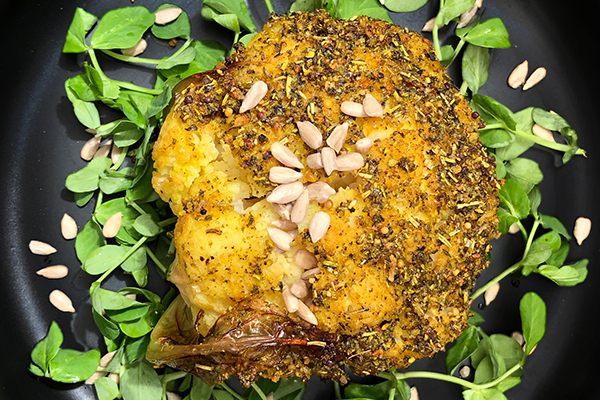
ROAST CAULIFLOWER
Preheat your oven to 180°C.
Meantime, wash and trim a head of cauliflower. Steam the whole head over boiling water for 6 minutes (depending on size!) until half cooked.
Paint the cauliflower (remember the underside!) with a mixture of 30ml olive oil, 30ml melted butter and 10ml Poultry Seasoning.
Place in the oven at 180°C and roast for 30 minutes until golden brown.
Perfect with roast chicken, pea-mash and chicken gravy...
Or serve with lentils & brown rice, pea shoots, sunflower seeds and a drizzle of smoked olive oil.
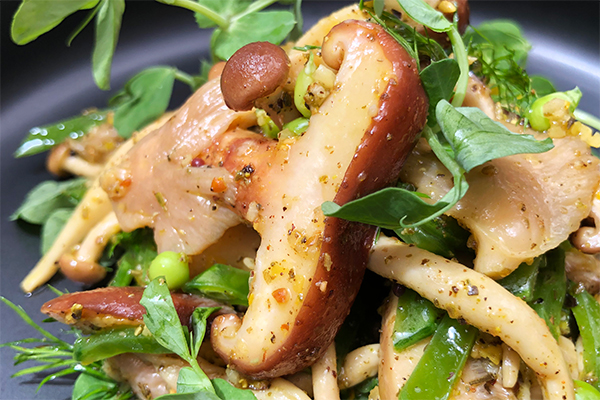
MARINATED MUSHROOM SALAD
Combine 75ml olive oil with 15ml white wine, 15ml vinegar, 15ml honey and 5ml Poultry Seasoning. Add the juice and a little of the rind of 1 lemon. Adjust seasoning. Clean and slice (if needed) 300g assorted mushrooms. Allow to marinade for 1 hour.
Slice 50g mange tout peas and stir through, add 50g fresh baby peas. Drain the mushroom mix and serve on baby leaf salad and fresh pea shoots.
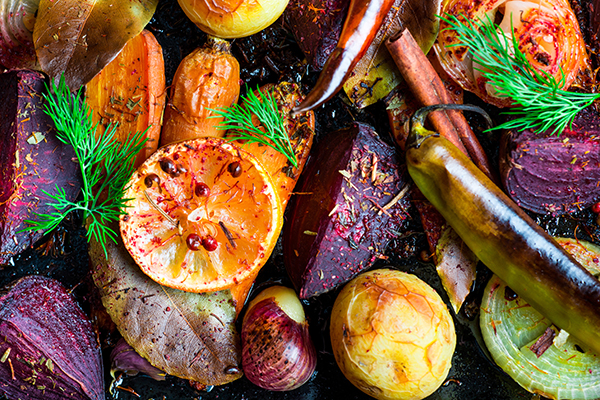
Sometimes, when the occasion demands it, add an operatic touch to the meal. Time to put together as much colour as you can can find, all together in one pan. Before roasting in a hot oven - around 190°C - until tender.
Pro-Tip: We seldom roast beetroots with other veg in the same pan - simply because if they are super-juicy beets (the delicious kind!) they might let go some of their juice and turn everything red. So, we roast the beets in a separate dish right alongside the rest of the veg and just before serving, create some space in the main pan and carefully spoon the roast beets in there.
Garnish with a few drops of lemon juice and a few scrapings of orange zest, and if you can find them - brilliant green, fennel fronds!
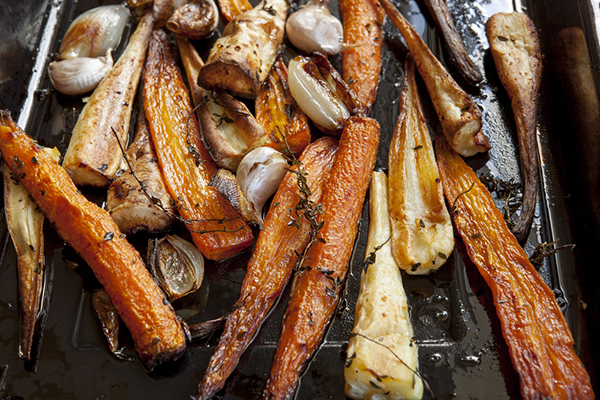
Poultry Seasoning loves roast parsnips and carrots with shallots and whole garlic!
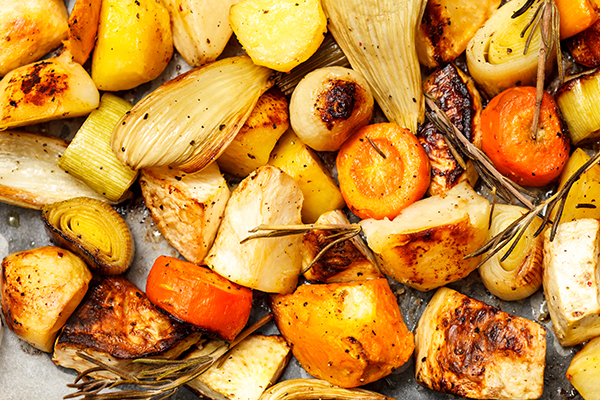
... and of course, fennel bulbs, sweet potato and onions too.
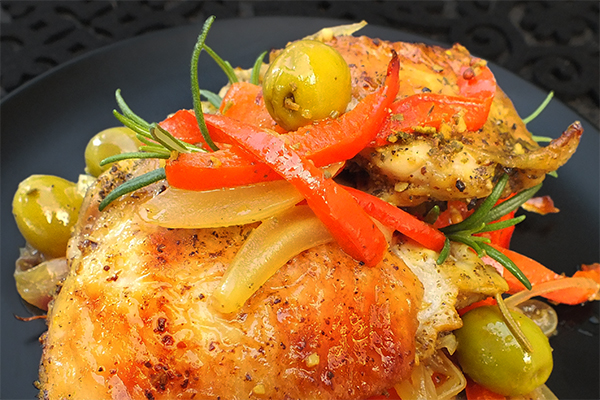
Chicken Thighs with Green Olives is one of those dishes that delivers way beyond expectation.
Start off by brushing 6 cleaned and dried chicken thighs with oil and seasoning them with Poultry Seasoning, well in advance. Optimally, 5-6 hours before, but if time is short, thighs are more robust than breasts, and more likely to 'forgive' a shorter dry marinading time.
Remove them from the fridge at least an hour before cooking so they can warm up to room temperature. If its a searing hot day in the kitchen - half an hour should be enough.
Slice red, yellow and orange peppers, along with petal-cut white onion and a shallot (also sliced lengthwise). Toss in a little oil and season with Poultry Seasoning.
Use a pan with a lid - copper or cast iron is good. Get the pan hot and brown the chicken thighs, skin side down for a couple of minutes. Turn them skin-side up. Turn the heat right down, cover the pan immediately and let them cook for 10-15 minutes. Add the prepped vegetables and ±60ml of light chicken stock and 15ml of dry white wine (or verjuice or 5ml cider vinegar in 10ml water). Adjust the heat so it is 'just' simmmering and cook for 15 minutes. Add a cup of green olives (we prefer to de-pit the olives), sprinkle with a few drops of lemon juice, turn the heat off and let the dish sit for 10 minutes before serving.
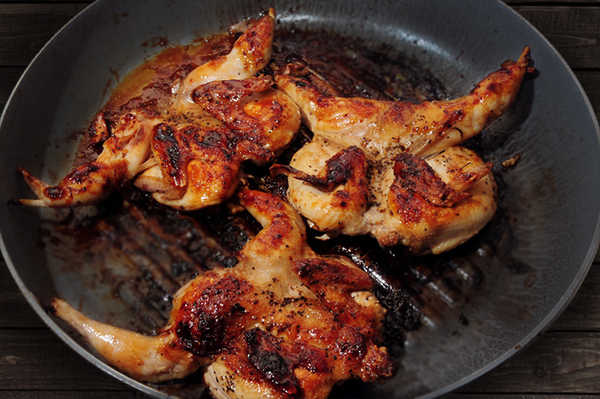
Cooking tiny quails to perfection is right out there with the culinary dark arts - the difference between perfection and epic failure is measured in half minutes and a few degrees of heat.
Start by cleaning, rubbing some oil onto the breast and seasoning your quails (with Poultry Seasoning of course!) at least 3 hours before you plan to cook them. Then take them out of the fridge an hour before - if you cook a fridge-cold quail it will not be at its best.
Get the pan HOT. Best to work in a copper or cast iron pan (this is not a job for one of the non-stick pans!). Use a meat press (or a smaller pan with a weight inside - like another pot with something heavy inside (like a large tin of jam or a few cooking stones!). Put the quails breast side down in the hot pan and weight them down. Monitor them carefully (this is not the time to multi-task). As soon as you smell brown skin - ±3 minutes - take them off the heat, flip the quails over, cover the pan with a lid and let them stand in the hot pan for another 3 or 4 minutes. Transfer the quails to a warm (±40°C) dish, cover them and let them rest for a further 10 minutes before serving.
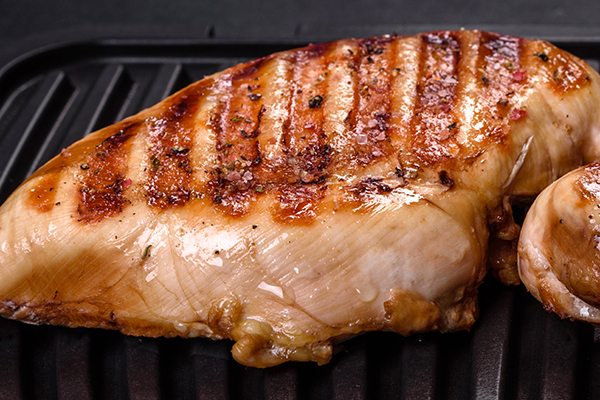
Chicken breast is another demon from the poultry kitchen. Misjudge the situation and instead of a succulent morsel, disaster - tough, dry chicken.
Again, the 'prep' should start several hours before... Clean and pat the breasts dry with a paper towel. Using a meat mallet or even a rolling pin, flatten the breasts so that they are more or less the same thickness all over (for even cooking). Now massage some sunflower oil into the meat - this is not just a case of brushing with oil - it really needs rubbing in properly. Season with Poultry Seasoning on all sides and store covered in the refrigerator until an hour before cooking.
Choose a copper or cast iron pan and get the pan HOT. Use a meat press (or a smaller pan with a weight inside - another pot full of water will work). Place the breasts, top side down in the hot pan and weight it down with a meat press or another smaller pan. Cook for ±3 minutes - take them off the heat, flip the breasts over, replace the weight and let them stand in the hot pan for another 3 or 4 minutes. Transfer the breasts to a warm (±40°C) dish, cover them and let them rest for a further 10 minutes.
If you dont trust your judgement, measure the internal temperature of the breast as it comes off the stove - it should be ± 75℃.
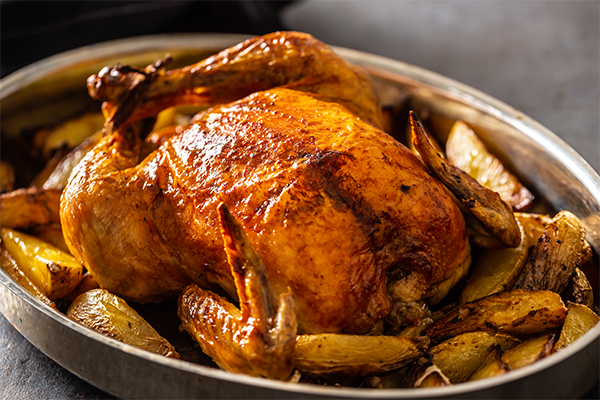
And then there's butter-roast chicken... The universal 'people-pleaser'!
What makes chicken tricky is that while we're all careful of raw chicken, everyone hates dry, overcooked chicken.
As is so often the case, choosing your chicken is supremely important - as is choosing your chicken supplier. If the bird smells 'fresh' with even, plump skin and firm springy meat on the breast and thighs, that's a great start.
Start well in advance - 5 or 6 hours is optimum. Clean the inside and dry the chicken skin. Rub it all over with some butter and Poultry Seasoning. Also smear some butter mixed with Poultry Seasoning under the breast skin. Cover and refrigerate until an hour before roasting.
If you're planning to roast vegetables (like chunks of potatoes or sweet potatoes) with the chicken, dredge them in oil and Poultry Seaoning and add a few extra pats of butter to the pan. The vegetables will slow down cooking, so consider that you might have to add 5-10 min to the open-roasting time (if needed).
Pre-heat the oven to 200℃. Place the chicken breast side down on a roasting tray, add the vegetables if desired and cover with foil. Put it in the oven and turn the heat down to 180℃. Roast covered for 45 minutes. Then take the cover off, turn the chicken, breast side up and roast uncovered for 30-45 minutes. If necessary turn the oven slightly hotter for a few minutes or boost it with a few minutes under the grill. This is where it all depends on the chicken and your oven - trust your judgement. When the internal temperature of the breast (or thigh) gets to 70℃, remove the chicken from the oven, cover with the foil again and let it rest in a warm (not hot!) place for at least 20 minutes before carving.
Chicken - actually all poultry - is a case where we (personally) cook with thermometers and timers and good judgement. If you take your bird out of the oven at 70℃ (at the thickest part of the breast or thigh) and let it rest in a warm place, it will reach the required 75℃, but if you keep it in the oven until it reaches 75℃, it will 'rest' up to 80℃ - way too much!
Remember the golden rule of meat: you can always cook meat a little more, but you cannot un-cook, overcooked meat!